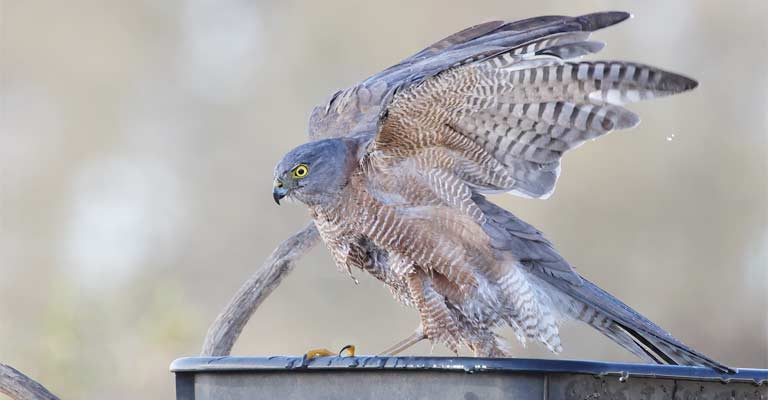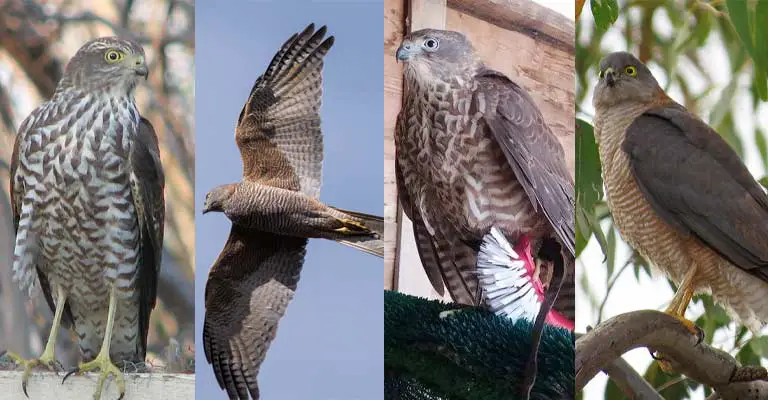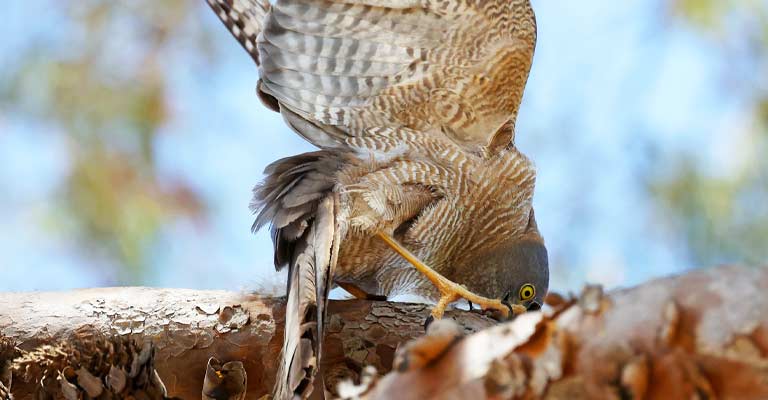The Collared Sparrowhawk (Accipiter cirrocephalus) is a captivating bird of prey that commands attention with its striking appearance and agile hunting prowess.
Belonging to the family Accipitridae and the genus Accipiter, this medium-sized raptor is known for its distinctive white collar, which encircles its neck and sets it apart within the avian kingdom.
Found in a variety of habitats, including woodlands, forests, and even urban areas, the Collared Sparrowhawk showcases adaptability in its lifestyle.
With bright yellow eyes that contribute to its keen eyesight, it navigates dense vegetation with remarkable precision during the pursuit of its primary prey small birds.
The Collared Sparrowhawk’s monogamous breeding habits, vocalizations, and nest-building skills add layers to its intriguing life history, making it a subject of fascination for bird enthusiasts and wildlife observers.
In this introduction, we embark on a journey into the captivating world of the Collared Sparrowhawk, exploring its unique characteristics and the role it plays in maintaining ecological balance. Stay sharp.

Identifying Characteristics of Collared Sparrowhawk
The Collared Sparrowhawk (Accipiter cirrocephalus) is a striking bird of prey known for its agile flight and distinctive physical features.
Identifying this specific raptor requires attention to several key characteristics that set it apart from other birds of prey. Here are some points to help you identify the Collared Sparrowhawk:
Size and Shape

The Collared Sparrowhawk is a medium-sized raptor with a length ranging from 30 to 40 centimeters. Its slender body and long tail give it a distinct silhouette, making it easily recognizable in flight.
The wings are short and rounded, contributing to its agile and maneuverable flying abilities.
Coloration
Adult Collared Sparrowhawks display a striking combination of colors. The upperparts are typically dark gray to black, while the underparts are finely barred with reddish-brown or orange.
The distinctive feature is the bold white collar around the nape of the neck, giving the bird its name.
Eye Color

Observing the eye color is crucial for identification. Collared Sparrowhawks have bright yellow eyes that contrast sharply with their dark facial markings.
This eye coloration is a significant distinguishing factor when compared to other birds of prey.
Tail Bands

The tail of the Collared Sparrowhawk is marked with several dark bands, which are more prominent in juveniles.
These bands contribute to the overall barred appearance of the underparts and aid in differentiating it from other similar raptors.
Habitat and Range
Understanding the bird’s habitat and distribution is essential for identification.
Collared Sparrowhawks are commonly found in woodlands, forests, and urban areas across their range, which includes parts of Australia, New Guinea, and nearby islands. They prefer dense vegetation for nesting and hunting.
Flight Pattern

Paying attention to the flight pattern can help distinguish the Collared Sparrowhawk from other birds.
They often fly low and rapidly through the vegetation, utilizing their short wings and long tail for quick and precise movements. Their flight is characterized by bursts of flapping interspersed with gliding.
Distinctive Call
Familiarizing yourself with the bird’s vocalizations can aid in identification. Collared Sparrowhawks produce a series of high-pitched, rapid calls, often described as a sharp “kee-kee-kee” or “kleeek-kleeek.”
Recognizing these distinctive vocalizations can help confirm the presence of this species in an area.
Behavioral Traits

Collared Sparrowhawks are skilled hunters, primarily preying on small birds. Observing their hunting behavior, which often involves sudden bursts of speed and agility, can be indicative of their presence.
They are known for their stealthy approach to prey, utilizing cover and surprise to their advantage.
Identifying the Collared Sparrowhawk involves a combination of physical characteristics, habitat considerations, and behavioral traits.
By paying attention to details such as coloration, eye color, tail bands, and distinctive calls, bird enthusiasts can confidently recognize and appreciate this captivating bird of prey.
Taxonomy of Collared Sparrowhawk

Here is a table outlining the taxonomy details of the Collared Sparrowhawk:
| Taxonomic Rank | Classification |
| Domain | Eukaryota |
| Kingdom | Animalia |
| Phylum | Chordata |
| Class | Aves |
| Order | Accipitriformes |
| Family | Accipitridae |
| Genus | Accipiter |
| Species | A. cirrocephalus |
The Collared Sparrowhawk (Accipiter cirrocephalus) belongs to the family Accipitridae within the order Accipitriformes.
This raptor is part of the diverse genus Accipiter, which includes various bird of prey species characterized by their medium to small size, powerful flight, and sharp talons.
Accipitridae, commonly known as hawks, eagles, and kites, is a family renowned for its predatory birds with keen eyesight and strong beaks.
The Collared Sparrowhawk shares its taxonomic lineage with other Accipiter species, showcasing a common evolutionary history and ecological niche within the broader avian landscape.
Collared Sparrowhawk Life History
The Collared Sparrowhawk (Accipiter cirrocephalus) is a fascinating bird of prey with a distinctive appearance and behavior.
Understanding its life history provides valuable insights into its ecology, behavior, and conservation needs.
Here, we delve into various aspects of the Collared Sparrowhawk’s life history, including its diet, habitat preferences, potential diseases, treatment options, and the conservation status of this remarkable raptor.
Food

Collared Sparrowhawks are skilled hunters, preying primarily on small birds. Their diet consists of a variety of avian species, including finches, small parrots, and other passerines.
Known for their agile flight, they employ stealth and surprise to catch their prey.
These birds are often observed swiftly maneuvering through dense vegetation in pursuit of their avian targets. While their diet is mainly avian, they may occasionally consume insects and small mammals.
Habitat
The Collared Sparrowhawk exhibits adaptability in its choice of habitat. These birds are commonly found in a range of environments, including woodlands, forests, and urban areas.
They favor locations with dense vegetation for nesting and hunting, using the cover to their advantage during pursuits.
The ability to thrive in various habitats contributes to the widespread distribution of the Collared Sparrowhawk across regions such as Australia, New Guinea, and nearby islands.
Range Map
The Collared Sparrowhawk’s distribution is extensive, covering diverse geographical areas.
A range map reveals their presence in Australia, stretching from the southern parts of Western Australia, across the eastern states, to Tasmania.
Additionally, their range extends into New Guinea and nearby islands. The adaptability of these birds allows them to inhabit both natural and human-altered landscapes.
Breeding

Breeding behavior in Collared Sparrowhawks is characterized by monogamous pair bonding.
The breeding season typically occurs from August to January, with nest construction and courtship rituals preceding egg-laying. Nests are built in dense vegetation, often at a considerable height above the ground.
Clutches typically consist of 2-5 eggs, and both parents contribute to incubation and raising the offspring. The fledglings become independent after several weeks of intensive parental care.
Diseases
Like many bird species, Collared Sparrowhawks may face health challenges. Avian diseases, parasites, and environmental factors can impact their well-being.
Common avian diseases include respiratory infections and parasites like mites and ticks.
Vigilance regarding signs of illness, such as lethargy or abnormal behavior, is crucial for early detection and intervention.
Treatment
Addressing diseases in Collared Sparrowhawks involves a multidimensional approach.
Veterinary care may be necessary for diagnosed illnesses, and rehabilitation centers play a crucial role in treating injured or sick birds.
Additionally, controlling external parasites through environmental management and regular monitoring contributes to the overall health of the population.
Conservation
The conservation status of the Collared Sparrowhawk is generally considered of least concern. However, ongoing habitat loss due to urbanization and deforestation poses a threat to their populations.
Conservation efforts focus on preserving and restoring suitable habitats, raising awareness about the importance of these raptors in maintaining ecological balance, and implementing measures to mitigate potential human-wildlife conflicts.
The life history of the Collared Sparrowhawk is a captivating narrative of adaptation, reproduction, and survival.
By understanding their food habits, habitat preferences, breeding behavior, potential health challenges, and conservation needs, we can work towards ensuring the continued existence of this remarkable bird of prey in our ecosystems.
Nesting Habit of Collared Sparrowhawk
Here’s a table summarizing the nesting details of the Collared Sparrowhawk (Accipiter cirrocephalus):
| Nesting Details | Facts |
| Clutch Size | 2 to 5 eggs |
| Number of Broods | Typically one brood per breeding season |
| Egg Length | Approximately 36 to 45 millimeters (mm) |
| Egg Width | Approximately 28 to 35 mm |
| Incubation Period | Around 30 days |
| Nestling Period | About 30 to 35 days |
| Egg Description | Generally pale bluish-white or greenish-white |
| Nest Type | Platform nest made of sticks and twigs |
| Nest Location | Positioned high in the canopy of trees or shrubs |
| Parental Involvement | Both parents contribute to incubation and care |
| Nest Building and Repair | Both parents participate in nest construction |
| Fledgling Independence | Fledglings become independent after several weeks of intensive parental care |
Understanding these nesting details provides valuable insights into the reproductive behavior and ecology of the Collared Sparrowhawk.
Their choice of nest location, parental involvement, and fledgling independence contribute to the overall life history and survival of this fascinating bird of prey.
10 Fun Facts About Collared Sparrowhawk
The Collared Sparrowhawk (Accipiter cirrocephalus) is a captivating bird of prey known for its agility, striking appearance, and intriguing behaviors.
Here are 10 fun facts that shed light on the unique characteristics and habits of this remarkable raptor.
- Distinctive Collar: As its name suggests, the Collared Sparrowhawk is recognized by the prominent white collar around its neck. This distinctive feature sets it apart from other birds of prey and adds to its aesthetic appeal.
- Size Matters: Despite its relatively small size compared to other raptors, the Collared Sparrowhawk is a formidable hunter. With a length ranging from 30 to 40 centimeters, it showcases agility and precision in flight.
- Agile Hunter: Known for its swift and agile flight, this bird employs its short wings and long tail to maneuver through dense vegetation in pursuit of small birds its primary prey.
- Yellow-eyed Stare: The bright yellow eyes of the Collared Sparrowhawk are a striking feature. These keen eyesight aids in spotting prey during flight and contributes to its effectiveness as a hunter.
- Versatile Habitat: The adaptability of the Collared Sparrowhawk is impressive. It can be found in a range of habitats, including woodlands, forests, and even urban areas, showcasing its ability to thrive in diverse environments.
- Monogamous Bond: Collared Sparrowhawks exhibit monogamous pair bonding during the breeding season. The male and female work together in constructing nests, incubating eggs, and raising their offspring.
- Distinctive Calls: The Collared Sparrowhawk communicates through a series of high-pitched calls, often described as a sharp “kee-kee-kee” or “kleeek-kleeek.” These vocalizations play a crucial role in establishing territory and communication between mates.
- Nest Construction: Building nests high in the canopy of trees or shrubs, Collared Sparrowhawks construct platform nests using sticks and twigs. Their nest-building skills showcase their resourcefulness and adaptability.
- Urban Residents: These birds are not averse to city living. Collared Sparrowhawks can be spotted in urban areas, showcasing their ability to coexist with human development while maintaining their hunting and nesting habits.
- Conservation Status: The Collared Sparrowhawk is generally considered of least concern regarding its conservation status. However, ongoing habitat loss emphasizes the importance of preserving suitable environments for these fascinating raptors.
The Collared Sparrowhawk’s unique features, behaviors, and adaptability make it a captivating subject for bird enthusiasts and wildlife observers alike.
These fun facts provide a glimpse into the intriguing world of this agile and charismatic bird of prey.
Wrapping Up
The Collared Sparrowhawk stands out as a remarkable bird of prey, characterized by its distinctive appearance, agile hunting prowess, and adaptability to various habitats.
From its striking white collar to its monogamous breeding habits, each aspect of its life history adds to the intrigue surrounding this captivating raptor.
Whether navigating dense vegetation in pursuit of prey or constructing nests high in the treetops, the Collared Sparrowhawk exemplifies resilience and resourcefulness.
Understanding its behaviors, nesting details, and conservation needs deepens our appreciation for the role it plays in maintaining ecological balance.
As these fascinating birds continue to thrive in diverse environments, their presence serves as a testament to the wonders of the avian world. Best of luck.